Dim Sum – Dishes that touch the heart
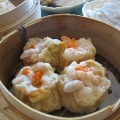 Dim sum are a wide range of small dishes usually eaten as part of ‘Yum Cha’, a Chinese morning or afternoon tea. Each piece of dim sum makes up a small morsel that will ‘touch the heart’. Here, we will introduce a few of the usual suspects, as well as some of our favourites!
Dim sum are a wide range of small dishes usually eaten as part of ‘Yum Cha’, a Chinese morning or afternoon tea. Each piece of dim sum makes up a small morsel that will ‘touch the heart’. Here, we will introduce a few of the usual suspects, as well as some of our favourites!
Har Gao – Shrimp Dumplings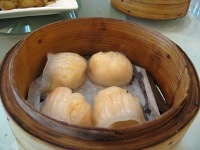
This steamed shrimp dumpling is one of the most popular dim sum dishes enjoyed for yum cha. Har gao are dumplings filled with diced or whole shrimps combined with pork fat and bamboo shoots, surrounded by a wheat and tapioca starch ‘shell’. The dumplings are steamed in bamboo steamers until the skins are translucent and slightly chewy and the shrimps are perfectly cooked, with a nice bite!
The perfect Har Gao dumpling skin should be thin enough to give a tantalising glimpse at the filling, yet strong enough to not break when picked up with chopsticks! Typically, Har Gao dumplings should have 7 or more pleats, however, skilled dim sum chefs will fold dumplings with 10 or more pleats.
Siu Mai – Pork & Shrimp Dumplings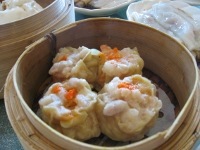
Siu Mai (AKA shaomai, shumai) are often ordered alongside Har Gao and are chopped pork dumplings wrapped in a wheat flour wrapper. The exposed top of the dumpling is usually topped by a small dot of orange crab roe, carrot or mushroom. Similar to its natural partner, har gao, these dumplings are steamed and served in bamboo baskets.
This popular dumpling is served all around East Asia, with each country adding their own flavour or take on it. However, the perfect Cantonese-style siu mai should have the perfect balance of pork and prawns (chopped, not minced, to give the dumplings just the right amount of bite), wrapped in thin, yellow pastry, and served piping hot.
Cheung Fun – Rice Noodle Rolls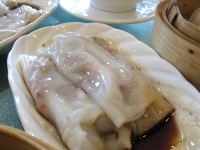
Cheung Fun are wide rice noodle rolls steamed in large sheets and then rolled up with different fillings, such as prawns, char siu barbecue pork and minced beef. A variant, containing crispy youtiao (Chinese savoury doughnut) is another popular cheung fun dish. The noodles are usually served with a lightly-flavoured sweet soy sauce. Cheung fun can also be served plain, with peanut and hoisin sauces for dipping or drizzling on top.
The noodles are made by pouring a thin layer of a batter, made with rice flour and water, into a square steaming pan. Fillings are added while the noodle is cooking and the whole sheet rolled up gently before serving. The perfect cheung fun should be silky and the noodles should be elastic, without being too chewy or gummy. This is similar to the Vietnamese dish, bánh cuốn.
Char Siu Bao – Roast Pork Buns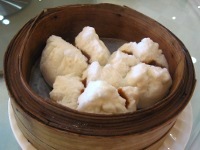
A fluffy white steamed bun filled with sweet barbecued pork, this is usually a favourite with younger dim sum eaters, who enjoy the sweet sticky BBQ pork filling. The bun filling comprises of diced char siu pork in a sweet-savoury sauce. A perfect steamed Char Siu Bao is so fluffy that they are said to be ‘smiling’, which means it bursts open at the top during steaming.
First timers often fail to notice the square of greaseproof paper that is usually on the base of the bun to stop it from sticking to the bottom of the steamer! Simply peel off before enjoying.
Dan Taat – Egg Custard Tarts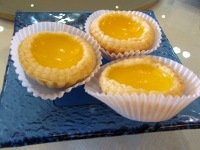
Something that may appear more familiar to diners new to dim sum are the dan taat – egg custard tarts. These can vary greatly between restaurants; from puff pastry, to shortcrust; from a small bite-sized morsel, to a more substantial sweet treat. No matter the style, it is seldom possible to eat an egg custard tart without getting crumbs all over yourself!
Typically, egg tarts served for dim sum are miniature in size. The pastry should be crisp and light, and the custard sweet and silky.
Wu Gok – Taro Puffs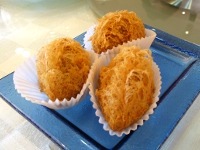
This dumpling is made with mashed taro (similar to a yam, or potato), and stuffed with a minced pork mixture before being deep fried. The most highly skilled chefs will produce fluffy-looking puffs, with a light and delicate web of crispy pastry around the outside. These dumplings are usually served warm, although beware; if freshly cooked, the contents can be extremely hot!
Chiu Chow Fun Gwor – Chiu Chow Style Dumplings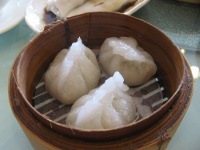
A thick translucent white dumpling skin surrounds a filling of ground pork, prawns, peanuts and chives. This steamed dumpling originates from the Chiu Chow (Chaozhou) region of China, and is usually served with chilli oil.
Xiao Long Bao – Shanghai Dumplings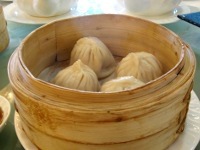
Xiao Long Bao (siu loong bao in Cantonese) is directly translated as little basket buns. Less of a bun and more of a dumpling, they are also known as soup dumplings, as they contain a delicious broth inside the delicate dumpling skin. XLB, as they are commonly known to enthusiasts, are usually served with a black rice vinegar dipping sauce, with slivers of ginger.
Xiaolongbao are usually filled with a minced pork filling. Sometimes, this is mixed with soup stock and frozen before being used to fill the dumplings in order to give them their trademark soup. Alternatively, a stock jelly, which melts upon heating, is wrapped into the dumplings.
Law Baak Go – White Radish (Daikon/Turnip) Cake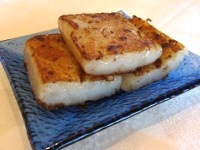
Don’t be fooled by the naming of this ‘cake’. Law Baak Go is actually a savoury patty of shredded white radish (also known as daikon, or mooli) and rice flour. Usually cut into squares, they are often served pan-fried, although can also be served steamed. Common additions to the standard base of white radish, rice flour and water, are flavourings such as dried shrimps, Chinese cured sausage and shiitake mushrooms.
Law Baak Go, should have plenty of radish for flavour, with evenly distributed ingredients. Larger (hand-cut) shreds of white radish add bite and to help keep the cakes from crumbling. It can be served with a variety of condiments like chilli oil, chilli sauce or hoisin sauce.
